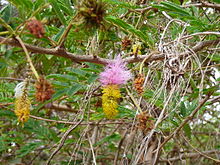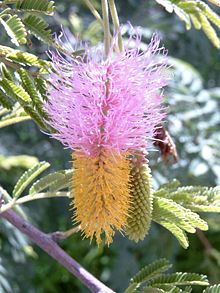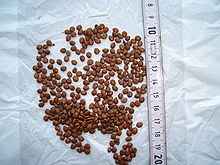- Dichrostachys cinerea
-
Sicklebush 
Scientific classification Kingdom: Plantae (unranked): Angiosperms (unranked): Eudicots (unranked): Rosids Order: Fabales Family: Fabaceae Genus: Dichrostachys Species: D. cinerea Binomial name Dichrostachys cinerea
Wight et Arn.Synonyms Cailliea dichrostachys Guill. et Perrot.
Dichrostachys glomerata Chiov.
Dichrostachys nutans (Pers.) Benth.
Dichrostachys nyassana Taub
Mimosa cinerea L.Dichrostachys cinerea, known as the Sicklebush, Bell mimosa, Chinese lantern tree or Kalahari Christmas tree (South Africa), is a legume of the genus Dichrostachys in the Fabaceae family.[1]
Common names include: acacia Saint Domingue (French), el marabu (Cuba), Kalahari-Weihnachtsbaum (German), kéké or mimosa clochette (Réunion)), sickle bush (South Africa).
Contents
Etymology
The generic name ‘Dichrostachys’ means '2-colored spike’ (in the sense of two-colored inflorescence) and ‘cinerea’ refers to the greyish hairs of the typical subspecies, obtained from the Greek ‘konis’ and the Latin ‘cineres’.
Distribution
It is native to Africa but can be found in India, the Caribbean and parts of Southeast Asia. In Ethiopia the species is common in the Nechisar National Park.[2]
The tree was introduced to the Caribbean in the 19th century .[3] In Cuba, where the plant is known as El Marabú or Marabou weed, it has been estimated that weed plants occupy close to five million acres (20,000 km²) of agricultural land. Possibly the weed could serve as a source of biomass for renewable power generation.[4]
Description and ecology
Dichrostachys cinerea is a semi-deciduous to deciduous tree characterized by bark on young branches, dark grey-brown fissures on older branches and stems and smooth on the spines. They typically grow up to 7 metres in height and have strong alternate thorns, generally up to 8 cm long. Flowers of the Dichrostachys cinerea are characteristically in bicoloured cylindrical spikes that resemble Chinese lanterns and are 6–8 cm long and fragrant.[5] Upper flowers of a hanging spike are sterile, and are of a lilac or pale purple. Pods are usually a mustard brown and are generally twisted or spiralled and may be up to 100 x 15 mm. The species has can be subcategorized with 2 slight variations that have been recognised. D. cinerea ssp. africana and D. cinerea ssp. nyassana, the latter which is typically larger and less hairy in its foliage.[1]
The species tends to grow in rainforest zones that are clearly defined and in altitudes up to 2,000 meters. It often occurs in areas with a strong seasonal climate with a wide ranging mean annual temperature and with a mean annual rainfall ranging from 200–400 mm. It occurs in brushwood, thickets, hedges, teak forest and grassland and generally takes to poorer quality clay soils or deep and sandy soils with a wide ph scale range.[1]
In India it can occur in dry deciduous forest.
In southern Africa, Dichrostachys cinerea generally flowers from October to February with fruiting from May to September. In Indonesia, however the species has been found flowering from September to June and fruiting from March to May. The tree generally grows at a medium to slow rate, 6–8 cm per year.
Uses
Fruit and seeds that grow on Dichrostachys cinerea are edible. Cattle, camels and game such as giraffe, buffalo, kudu, hartebeest, nyala, red forest duiker and Damara dik-dik feed on the juicy pods that fall to the ground. Such animals also feed on the immature twigs and leaves of the tree which are rich in protein (11-15%) and minerals. The flowers can be a valuable source of honey. The wood is of a dense nature and burns slowly with no toxicity, so it is often used for fuelwood. The species yields a medium to heavy, durable hardwood and are often used in smaller domestic items as walking sticks, handles, spears and tool handles particularly in central Africa. In medicine, bark is used to alleviate headache, toothache, dysentery, elephantiasis and root infusions are consumed to treat leprosy, syphilis, coughs, as an anthelmintic, purgative and strong diuretic. The leaves are particularly useful and can be beaten to treat epilepsy and can also be taken as a diuretic and laxative, and its powder can be used in the massage of fractures.[1]
In Siddha medicine of the Tamils, Dichrostachys cinerea is called "vidathther" and used to treat gonorrhea, syphilis and eczema. The actual medical preparations can be seen in a book on Siddha medicine.[6]
The roots have been known to treat bites or stings. As they are rich in nutrients they are often used as a manure, particularly in the Sahel region of Africa along the riverbanks.[7] The plant is widely used for soil conservation, particularly in India, for shallow soils, and in arid western and subhumid alluvial plains.
Although it has its uses, it is considered a threat to agricultural production and is listed on the Global Invasive Species Database [3]
It is also used a an indoor bonsai specimen .http://www.bonsaiboy.com/catalog/product5334.html
References
- ^ a b c d World Agroforestry Centre, Retrieved on June 22, 2008
- ^ Nechisar National Park, Realethiopia.com, January 4, 2006, Retrieved on June 22, 2008
- ^ a b Global Invasive Species Database, Retrieved on June 22, 2008
- ^ A Weed that Could Bring Cuba Power by Fernando Ravsberg, HavanaTimes.org, June 24, 2010
- ^ Guide to the Tree Species of Southern Africa:Dichrostachys cinerea - Sickle Bush, Eco Travel Africa, Retrieved on June 22, 2008
- ^ Dr.J.Raamachandran, HERBS OF SIDDHA MEDICINES-The First 3D Book on Herbs, pp.76
- ^ Vogt K., (1995), A field guide to the identification, propagation and uses of common trees and shrubs of dryland Sudan, SOS Sahel International (UK)., Retrieved on June 22, 2008
External links
Categories:- Dichrostachys
- Flora of Africa
- Flora of India
- Invasive plant species
Wikimedia Foundation. 2010.



